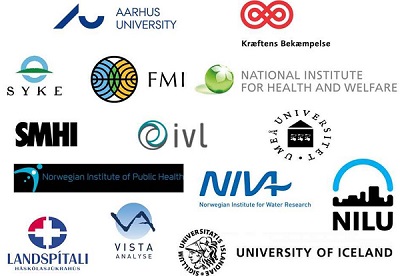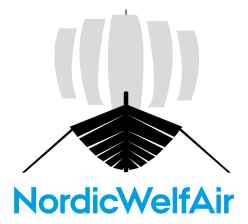- a large interdisciplinary Nordic project funded by NordForsk
The expected overall results from this highly interdisciplinary project will be new knowledge about health effects of air pollution. Focus is on what kind of air pollution with respect to chemical composition and sources that causes the impacts from air pollution on human health for different target/population groups and on assessing the effects on the well-being and welfare.
The obtained results will form the basis for exploring the impacts on the distribution of welfare in the Nordic countries at population group level, for whole populations at national scale and between the Nordic countries.
Furthermore, new knowledge on the challenges this will have for the Nordic welfare systems is expected resulting in development of policy options proposing solutions to the public health and welfare challenges.
The research collaboration will run for five years and has 16 partners from the Nordic countries.
The project is coordinated by Prof. Jørgen Brandt (jbr@envs.au.dk) and Senior Scientist Camilla Geels (cag@envs.au.dk), Department of Environmental Science, Aarhus University.


The project: Understanding the link between Air pollution and Distribution of related Health Impacts and Welfare in the Nordic countries – NordicWelfAir – is funded through NordForsk’s Nordic Programme on Health and Welfare.
The project will run for five years and has been granted funding of NOK 30 million.

Air pollution has serious impacts on human health, wellbeing and welfare. The main challenge is to understand how to regulate air pollution in an optimal way both on global and local scales.
Linking the detailed information of the spatio-temporal distribution of air pollution levels and the chemical composition of the atmospheric particles with register data for mortality and morbidity, we have a unique opportunity in the Nordic countries to gain new understanding of the various health impacts from different kinds of air pollution from different kind of sources.
This will provide the basic understanding needed for policy making of strategies to optimally reduce the air pollution challenge and to assess the related impacts on the distribution of health impacts and related societal costs and welfare.
The results from the project will be used in both a Nordic as well as global perspective to improve the health and welfare by finding the optimal solutions to societal and public health challenges from air pollution through high-quality research.
The results from the research in this project have the potential to act as new international standards in our understanding of health impacts from air pollution for different population groups due to the possibility to integrate the unique data and knowledge of air pollution, register, health, socio-economics, and welfare research in the Nordic countries in a highly interdisciplinary project.
The study will provide a Nordic contribution to international research on the topics of environmental equality and justice within the area of air quality related risks, amenities and wellbeing.
By combining register data on all singleton births in the greater Stockholm during 2006-2013 and modelled exposure data, the link between early-life exposure and asthma risk is investigated.
Olsson, D., Forsberg, B., Bråbäck, L., Geels, C., Brandt, J., Christensen, J., H., Frohn, L. M, Oudin, A., Early childhood exposure to ambient air pollution is associated with increased risk of paediatric asthma: An administrative cohort study from Stockholm, Sweden, 2021, Environ Int; 155:106667. https://doi.org/10.1016/j.envint.2021.106667
In this study, we present a novel residential wood combustion emission inventory for the Nordic countries based on national inventories and new gridding of the emissions.
Paunu, V.-V., Karvosenoja, N., Segersson, D., López-Aparicio, S., Nielsen, O.-K., Plejdrup, M. S., Thorsteinsson, T., Niemi, J. V., Vo, D. T., Denier van der Gon, H. A. C., Brandt, J., and Geels, C.: Spatial distribution of residential wood combustion emissions in the Nordic countries: How well national inventories represent local emissions?, 2021, Atmospheric Environment, 264, 118712, https://doi.org/10.1016/j.atmosenv.2021.118712
This study aims to estimate the mortality risk associated with air pollution in a Swedish cohort with relatively low exposure. Air pollution models were used to estimate annual mean concentrations of a number of air pollution components (PM2.5, BC/pOC), sea salt, SIA and SOA, O3 and NO2.
Sommar, J.N.; Hvidtfeldt, U.A.; Geels, C.; Frohn, L.M.; Brandt, J.; Christensen, J.H.; Raaschou-Nielsen, O.; Forsberg, B. Long-Term Residential Exposure to Particulate Matter and Its Components, Nitrogen Dioxide and Ozone—A Northern Sweden Cohort Study on Mortality. Int. J. Environ. Res. Public Health 2021, 18, 8476. https://doi.org/10.3390/ijerph18168476